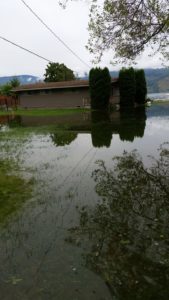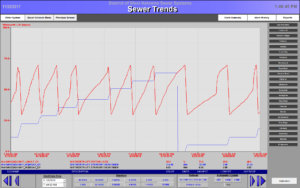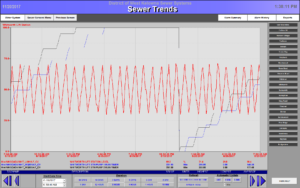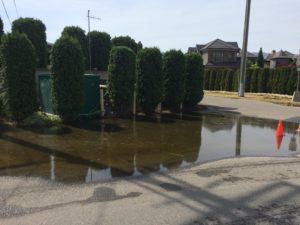The flash flooding and lake inundation experienced in West Kelowna this year will go down in the history books as an extremely challenging time period for our municipality. Known as the 2017 Freshet Event, the City of West Kelowna’s (CWK) response efforts included significant ‘boots on the ground’ participation from Parks, Public Works, Fire and Rescue, as well as many from City Hall who supported this team with their participation at the EOC.
 Some of the factors that contributed to the 2017 Freshet Event include: late season (March and April) heavy snowfall/snowpack, followed by an extremely rainy and wet April into May, overly saturated ground conditions, and then significant and localized storm cells. These were a perfect storm of conditions that forced road and bridge closures, slope failures, flooded homes and properties, loss of parks, and impacts on critical infrastructure. This article will focus on the latter, specifically how the CWK’s wastewater collection system was impacted.
Some of the factors that contributed to the 2017 Freshet Event include: late season (March and April) heavy snowfall/snowpack, followed by an extremely rainy and wet April into May, overly saturated ground conditions, and then significant and localized storm cells. These were a perfect storm of conditions that forced road and bridge closures, slope failures, flooded homes and properties, loss of parks, and impacts on critical infrastructure. This article will focus on the latter, specifically how the CWK’s wastewater collection system was impacted.
By mid-May it was becoming evident that the climbing lake levels were no longer just coffee room conversation. Not only was the inundation flooding a real concern to our community living on the waterfront but the rising lake levels were also becoming a significant concern for a good portion of the CWK’s critical infrastructure located within this ‘lake level’ elevation. This critical infrastructure included five (of 27) sanitary sewer lift stations and associated collection mains.
With respect to the wastewater collection system, our SCADA system was recording data from our sanitary lift stations that was higher than we had ever seen. This appeared to indicate that the collection system was being subjected to very high infiltration and/or inflow. Considering the elevations that the lake had risen to, infiltration of the system was unavoidable, but it was the unknowns of the extent of additional inflow that really had us in trouble and worrying. We had inflow/infiltration coming from low lying on-property clean outs, inspection chamber caps, and as was eventually discovered, from some homeowners that felt the collection system was a venue to remove their own ground water and flooded basements. Some of what made this inflow/infiltration even more challenging included collection systems that were installed with clay pipes and with no inspection chambers. This obviously made it difficult to identify where some of the inflow might be coming from. Other challenges included a mobile home park where flood levels were breaching underneath the trailers at the same height as their sewer connections or stratified lake level communities where our knowledge of the onsite system was limited.
We had to do something, but not knowing if we had full cooperation from all residents affected, we were very worried that our sanitary infrastructure would not be able to keep up to the infiltration and inflow that was coming at us. Not only was this problematic for the CWK’s wastewater collection system, but it was also becoming a significant concern for the Regional District of Central Okanagan’s wastewater treatment plant where all of the CWK’s, Westbank First Nation and Peachland sanitary flows are treated. This had the potential to become a very unsettling situation for many jurisdictions in the area.
So, on top of all of the significant flood prevention work that was happening along the CWK foreshore, we then found ourselves with a significant inflow problem that needed to be addressed immediately. With the help from CWK Bylaw, CWK Fire and Rescue, the BC Forestry Service, the response team headed out to try and tackle the suspected problem. This including a door-to-door campaign of education of how the sewer system works and ensuring no one was using the sewer system as a route for removing their own onsite and in-house water challenges.
We can’t thank these teams enough for how they stepped up to the plate working these subdivisions finding where the inflow was coming from and getting into our systems. In some cases, we had team members helping the homeowners mitigate these connections and came up with alternative measures to evacuate their flooding challenges. This allowed our CWK Utilities team to continue working through extreme pumping situations that our stations were being tasked with.
Notable findings and considerations from the 2017 Freshet Event are trimming stations to keep more water in the vessel to help them from becoming buoyant, trimming variable frequency drives to find a constant run speed in an attempt to eliminate as many pump starts as possible, continue to engage in an inspection chamber locating program, utilization and cooperation with local emergency service workers, knowledge of your system and its capacities, as well as public awareness of local community utility systems.
By Chris Anderson (Public Works Manager) and Brian Bidewell (EOCP Certified Operator (WD I, WWC III)).
To see the full Operator Digest – click here.



